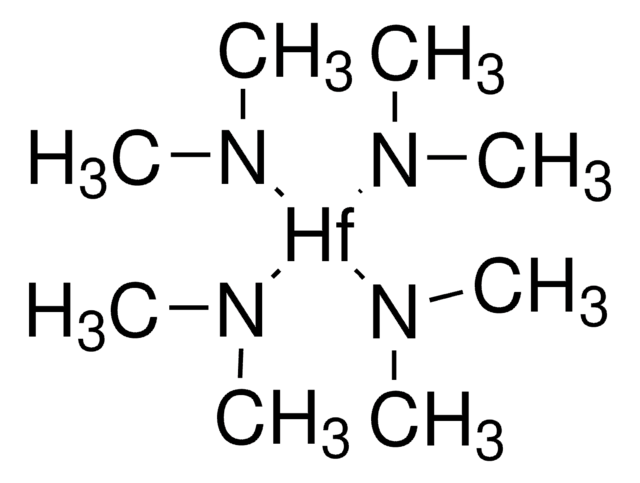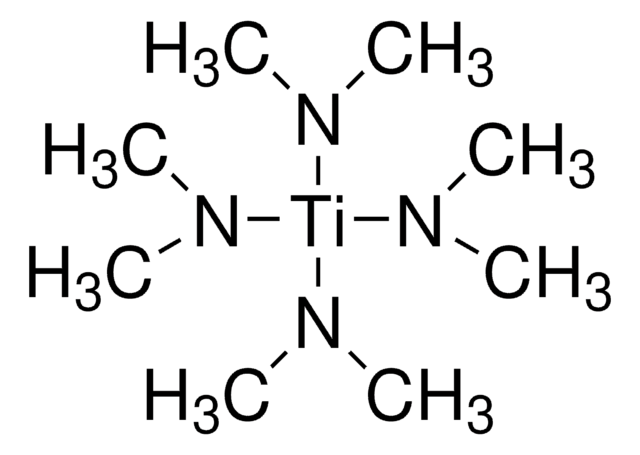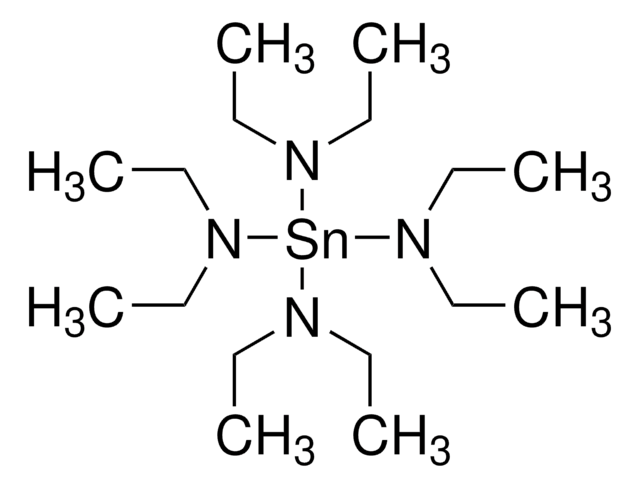698431
Tetrakis(dimethylamido)tin(IV)
99.9% trace metals basis
Synonym(s):
Tin(IV) dimethylamide
Sign Into View Organizational & Contract Pricing
All Photos(1)
About This Item
Linear Formula:
[(CH3)2N]4Sn
CAS Number:
Molecular Weight:
295.01
MDL number:
UNSPSC Code:
12352103
PubChem Substance ID:
NACRES:
NA.23
Recommended Products
Quality Level
Assay
99.9% trace metals basis
form
liquid
reaction suitability
core: tin
SMILES string
CN(C)[Sn](N(C)C)(N(C)C)N(C)C
InChI
1S/4C2H6N.Sn/c4*1-3-2;/h4*1-2H3;/q4*-1;+4
InChI key
WHXTVQNIFGXMSB-UHFFFAOYSA-N
Looking for similar products? Visit Product Comparison Guide
General description
Atomic number of base material: 50 Tin
Signal Word
Danger
Hazard Statements
Precautionary Statements
Hazard Classifications
Acute Tox. 4 Oral - Flam. Liq. 2 - Skin Corr. 1B
Storage Class Code
3 - Flammable liquids
WGK
WGK 3
Flash Point(F)
18.0 °F - closed cup
Flash Point(C)
-7.8 °C - closed cup
Personal Protective Equipment
dust mask type N95 (US), Eyeshields, Gloves
Choose from one of the most recent versions:
Already Own This Product?
Find documentation for the products that you have recently purchased in the Document Library.
Customers Also Viewed
Sarai García-García et al.
Chemical science, 10(7), 2171-2178 (2019-03-19)
Atomic layer deposition is a chemical deposition technology that provides ultimate control over the conformality of films and their thickness, even down to Ångström-scale precision. Based on the marked superficial character and gas phase process of the technique, metal sources
Hao-Cheng Yang et al.
ACS nano, 12(8), 8678-8685 (2018-08-15)
Crude oil fouling on membrane surfaces is a persistent, crippling challenge in oil spill remediation and oilfield wastewater treatment. In this research, we present how a nanosized oxide coating can profoundly affect the anti-crude-oil property of membrane materials. Select oxide
Yasemin Saygili et al.
Chemphyschem : a European journal of chemical physics and physical chemistry, 19(11), 1363-1370 (2018-04-27)
In perovskite solar cells (PSCs), the most commonly used hole transport material (HTM) is spiro-OMeTAD, which is typically doped by metalorganic complexes, for example, based on Co, to improve charge transport properties and thereby enhance the photovoltaic performance of the
Benjamin Lamm et al.
ChemSusChem, 12(9), 1916-1924 (2018-12-21)
Bismuth vanadate (BiVO4 ) is promising for solar-assisted water splitting. The performance of BiVO4 is limited by charge separation for >70 nm films or by light harvesting for <700 nm films. To resolve this mismatch, host-guest architectures use thin film coatings on
Articles
High Purity Metalorganic Precursors for CPV Device Fabrication
Global Trade Item Number
| SKU | GTIN |
|---|---|
| 698431-1G | 4061832794082 |
| 698431-5G | 4061838632821 |
Our team of scientists has experience in all areas of research including Life Science, Material Science, Chemical Synthesis, Chromatography, Analytical and many others.
Contact Technical Service



![Bis(trimethylaluminum)-1,4-diazabicyclo[2.2.2]octane adduct](/deepweb/assets/sigmaaldrich/product/structures/978/293/6c8c7fbe-4b40-4576-bd40-94ac58cbe057/640/6c8c7fbe-4b40-4576-bd40-94ac58cbe057.png)






